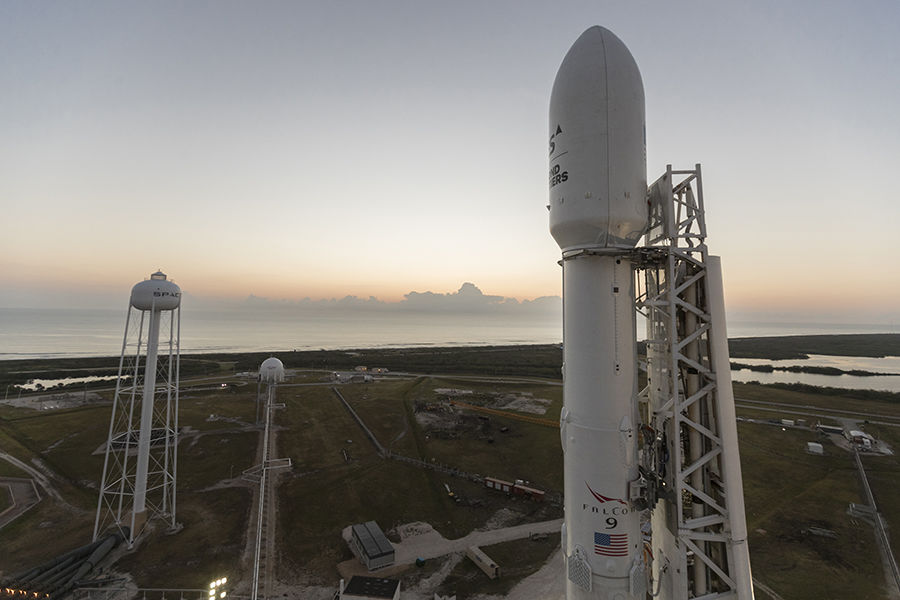Blast Off into the Future: SpaceX Revolutionizes Space Travel with Upgraded Starship Vehicle The space exploration landscape is on the cusp of a groundbreaking transformation, courtesy of Elon Musk’s visionary brainchild, SpaceX. After months of anticipation, the private aerospace giant is poised to unveil the latest iteration of its ambitious Starship program, designed to boldly push the frontiers of space travel. The upgraded Starship vehicle, packed with cutting-edge technology and innovations, promises to redefine the possibilities of interstellar exploration, lunar missions, and even establishing a permanent human presence on Mars. As the space community holds its collective breath, Gizmoposts24 brings you the inside scoop on the eagerly awaited debut of SpaceX’s revamped Starship, and what this monumental leap forward means for the future of space exploration. Get ready to embark on a journey that will take you to the edge of the cosmos and beyond, as we delve into the exciting details of SpaceX’s latest masterpiece.
SpaceX Starship Upgrades and Launch Preparations
Debut of Starship V2: Significant Changes and Improvements

As SpaceX prepares for the seventh test flight of its mega-rocket, the company is set to debut the new and improved Starship V2. This upgraded version features significant changes, taking lessons from previous flight tests to improve reliability and performance. The upgrades include a height increase of nearly 2 meters and a 25% stretch in the tanks to house more propellant, boosting Starship’s payload capacity to 100+ tons to Low Earth Orbit (LEO).
The propulsion system has also been upgraded with the addition of vacuum jacketed feedlines to minimize cryogenic fuel boil-off. Furthermore, the forward flaps used for vehicle control on reentry are now positioned higher on the vehicle and further away from the heat shield. The avionics system has been completely overhauled to support increasingly complex missions, including in-space propellant transfers and a second-stage Starship catch.
Upgraded Propulsion System: Minimizing Cryogenic Fuel Boil-Off
The upgraded propulsion system is designed to reduce cryogenic fuel boil-off, which is a significant challenge in space exploration. By minimizing fuel boil-off, SpaceX can increase the efficiency of its missions and reduce the amount of fuel required. This is particularly important for long-duration missions, where fuel efficiency is crucial.
Enhanced Avionics and Heat Shield: Supporting Complex Missions
The enhanced avionics system and heat shield are designed to support complex missions, including in-space propellant transfers and second-stage Starship catches. The new avionics system provides improved navigation, communication, and control capabilities, while the heat shield is designed to protect the vehicle from the intense heat generated during reentry.
Starship Payload and Deployment Capabilities
First Payload Deployment: 10 Dummy Starlink Satellites
For the first time, SpaceX will attempt to deploy payloads on the seventh test flight of its Starship. The mission will deploy 10 dummy Starlink satellites, marking an important milestone in the development of the Starship program. This test run will pave the way for future large-scale deployments of next-gen satellites on Starship.
The deployment of dummy satellites will allow SpaceX to test its payload deployment capabilities and gather valuable data on the performance of the Starship vehicle. This data will be used to refine the design and operation of the vehicle, ensuring that it can safely and efficiently deploy payloads in the future.
Implications for Future Large-Scale Deployments: Next-Gen Satellites on Starship
The successful deployment of dummy satellites on this mission will have significant implications for future large-scale deployments of next-gen satellites on Starship. With its advanced payload deployment capabilities, Starship will be able to carry a wide range of payloads, including satellites, spacecraft, and even crewed missions.
Practical Aspects of Payload Deployment: Test Run for Technically Challenging Missions
The payload deployment on this mission is not only a test of the Starship vehicle’s capabilities but also a test run for technically challenging missions. The deployment of dummy satellites will allow SpaceX to refine its payload deployment procedures and identify any issues that may arise during the mission.
Technological Advancements and Future Missions
Introduction of Metal Heat Tiles: Active Cooling and Heat Shielding Solutions
SpaceX is introducing metal heat tiles on the Starship vehicle, which will provide active cooling and heat shielding solutions. These tiles are designed to protect the vehicle from the intense heat generated during reentry and will play a critical role in the development of the Starship program.
The use of metal heat tiles is a significant technological advancement, as it will allow SpaceX to improve the efficiency and safety of its missions. The tiles will be able to withstand the high temperatures generated during reentry, reducing the risk of damage to the vehicle and its payloads.
Reusability and Reliability: Booster Catch and Second-Stage Starship Catch
SpaceX is working towards achieving reusability and reliability in its missions, with the goal of catching the booster and second-stage Starship. This will allow the company to significantly reduce the cost of access to space and increase the efficiency of its missions.
Starship-to-Starship In-Space Propellant Transfer: Milestone for NASA’s Moon and Mars Goals
The Starship-to-Starship in-space propellant transfer is a critical milestone for NASA’s Moon and Mars goals. This technology will allow SpaceX to transfer propellant between spacecraft, enabling longer-duration missions and reducing the amount of fuel required.
SpaceX’s Ambitious Plans and Collaborations
Polaris Program: Rapidly Advancing Human Spaceflight Capabilities
SpaceX is collaborating with the Polaris Program, a first-of-its-kind effort to rapidly advance human spaceflight capabilities. The program will consist of up to three human spaceflight missions, demonstrating new technologies and conducting extensive research.
The Polaris Program will play a critical role in the development of SpaceX’s Starship program, allowing the company to test its capabilities and refine its design. The program will also provide valuable insights into the challenges and opportunities of human spaceflight, paving the way for future missions to the Moon and Mars.
Partnership with Shift4: Raising Funds and Awareness for Important Causes
SpaceX is partnering with Shift4, a company founded by Jared Isaacman, to raise funds and awareness for important causes. The partnership will support the development of the Starship program and provide opportunities for charitable giving.
Implications for the Space Industry: Private Sector Contributions to Space Exploration
The partnership between SpaceX and Shift4 highlights the importance of private sector contributions to space exploration. The collaboration will demonstrate the potential for private companies to drive innovation and advancement in the space industry, paving the way for future missions and discoveries.
Launch Schedule and Countdown
Wednesday’s Planned Launch: Seventh Test Flight and Important Firsts
The seventh test flight of the Starship is scheduled to launch on Wednesday, marking an important milestone in the development of the program. The mission will be the first to debut the new and improved Starship V2 and will attempt to deploy payloads for the first time.
The launch will be a significant test of the Starship vehicle’s capabilities, demonstrating its ability to carry payloads and support complex missions. The success of the mission will pave the way for future launches and deployments, marking an important step forward for the Starship program.
Countdown to Liftoff: Pre-Launch Preparations and Final Checks
The countdown to liftoff has begun, with pre-launch preparations and final checks underway. The SpaceX team is working tirelessly to ensure that the vehicle is ready for launch, conducting a series of tests and checks to verify its systems and subsystems.
Real-Time Updates: Gizmoposts24 Coverage of the Starship Launch and Mission
Gizmoposts24 will provide real-time updates on the Starship launch and mission, offering exclusive coverage and analysis of the event. Our team of experts will provide insights and commentary on the mission, highlighting its significance and implications for the space industry.
Challenges and Opportunities in Space Technology
Overcoming Technical Challenges: Lessons from Previous Flight Tests
SpaceX has faced numerous technical challenges in the development of the Starship program, with previous flight tests providing valuable lessons and insights. The company has used these lessons to refine its design and operation, overcoming the challenges and pushing the boundaries of space technology.
The technical challenges faced by SpaceX are not unique to the company, with many organizations and individuals working to overcome similar hurdles. The development of space technology is a complex and challenging field, requiring significant investment and innovation.
Opportunities for Innovation: Improving Reliability and Performance
Despite the challenges, there are numerous opportunities for innovation in space technology, with companies like SpaceX pushing the boundaries of what is possible. The development of new materials, technologies, and systems is driving innovation, improving reliability and performance, and reducing costs.
Analysis of SpaceX’s Approach: Balancing Risk and Reward in Space Exploration
SpaceX’s approach to space exploration is characterized by a willingness to take risks and push the boundaries of what is possible. The company’s founder, Elon Musk, has stated that he is willing to take risks to achieve his goals, recognizing that failure is an inevitable part of the innovation process.
SpaceX’s Role in the Future of Space Exploration
NASA’s Moon and Mars Goals: Starship’s Critical Role in Upcoming Missions
SpaceX’s Starship program will play a critical role in NASA’s upcoming missions to the Moon and Mars. The vehicle’s advanced capabilities and reusability make it an ideal candidate for these missions, which will require significant investment and innovation.
The success of the Starship program will be crucial to the success of NASA’s Moon and Mars goals, providing a reliable and efficient means of transporting crew and cargo to the lunar and Martian surfaces. The program will also pave the way for future missions, including the establishment of a permanent human presence on the Moon and Mars.
Private Sector Contributions: SpaceX’s Impact on the Space Industry
Conclusion
In conclusion, SpaceX’s upcoming debut of the upgraded Starship vehicle marks a pivotal moment in the pursuit of interstellar travel and humanity’s quest to become a multi-planetary species. As discussed in this article, the new design boasts significant improvements to its payload capacity, reusability, and propulsion systems, positioning it as a game-changer for both satellite deployment and lunar/Mars missions. The implications of this technological leap are far-reaching, with the potential to democratize access to space, accelerate scientific discovery, and unlock new economic opportunities.
As we look to the future, the success of the upgraded Starship vehicle could pave the way for a new era of space exploration and development. With SpaceX’s ambitious plans to establish a permanent human settlement on Mars, this vehicle could play a crucial role in transporting both people and cargo to the Red Planet. Moreover, the private sector’s increasing involvement in space technology could lead to a paradigm shift in how we approach space travel, with private companies like SpaceX driving innovation and reducing costs.
As we stand on the cusp of this new frontier, it’s essential to recognize the profound implications of SpaceX’s achievement. The Starship vehicle represents not only a technological marvel but also a testament to human ingenuity and our innate desire to push beyond the boundaries of what’s thought possible. As Elon Musk once said, “When something’s important enough, you do it even if the odds are against you.” With the upgraded Starship vehicle, the odds of humanity becoming a multi-planetary species have never looked more promising. The question is, what’s next?


Add Comment